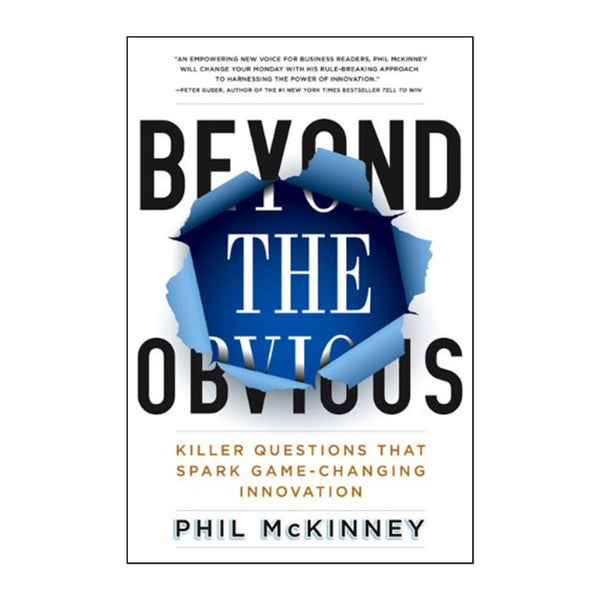How To Drive Innovation In Your Organization
Innovation is a concept that most people struggle to define. To use the test established in the 1964 by United States Supreme Court Justice Potter Stewart to define profanity — "I know it when I see it". Innovation can be the new product, redesigned process, a new marketing campaign, or even a great idea for lunch. Innovation comes in many shapes and sizes, but no matter what form it takes, one thing is certain: it never happens by accident.
What are some reasons to think of introducing innovations in your business? You may have heard some grand stories about instilling innovative thinking within an organization but are unsure how to handle this challenge. A recent survey of 400 executives on innovation showed that 77% tried to foster it. However, only 14% believe they can do so effectively.
There are several reasons introducing innovations into your business can be a great idea. For one, innovation can help your business stay ahead of the competition. It can help you innovate new and better ways to meet the needs of your customers. Innovation can lead to the development of new products or services, which can help you grow your business.
However, driving innovation within an organization can be a challenge. To be successful, it's important to understand innovation and how it works. You also need to have a clear vision and innovation strategy for how you want your organization to be innovative. Then you need to create an environment that supports innovation and encourages employees to drive it.
PART 1: INNOVATION STRATEGY
What is innovation?
Innovation is creating innovative products/services and implementing them in a new or different way. It can involve the development of new processes, services, or even products. Innovation can also involve reworking or redesigning existing ones.
Innovation often involves putting together new combinations of ideas, goods, and services. Innovation is about doing things differently than they've been done before by your organization.
Innovative thinking can drive a lot of positive results for your business. It may lead to new products, services, and ways of doing business. Sometimes, innovation can drive growth in sales or revenue.
How do you want your organization to be innovative?
So, how do you want your organization to be innovative? Be the first to come out with new products or services? Or the best at meeting the needs of your customers? Maybe you want it to be known for its creativity and innovation.
Whatever your goal may be, it's important to have a clear vision for how you want your organization to be innovative. This will help you develop a plan for how to achieve this goal. It will also help you create an environment that supports innovation and encourages employees to drive it.

What does an innovation strategy include?
An innovation strategy should include clear goals, an innovation process for generating new ideas, and a way to select and implement the best innovative ideas. It's important to have support from everyone in the organization. It needs to be cross-functional and include those from top leaders to frontline employees.
To execute the innovation strategy, establish an Innovation Program Office (IPO). The IPO develops and implementing the innovation strategy. The IPO should include representatives from all parts of the organization, including sales, marketing, operations, and R&D. Ideally, a senior leader should drive the IPO and set the vision of what they believe the organization can achieve.
PART 2: THE WHY AND HOW OF DRIVING INNOVATION
What does driving innovation mean?
In order to drive innovation within an organization, staff and leaders must foster new thinking and challenge the status quo. How? By implementing new ideas and strategies and encouraging employees to think outside the box. By creating a culture of innovation, businesses can drive growth and success.
1) Fostering New Thinking
What does it take to foster new thinking? This means breaking out of the mold, thinking differently, and being open to new ideas. It also means not being afraid to take risks and experiment. It isn't just about coming up with new ideas. You also need to be open to hearing them from others, even if they don't seem feasible at first. Encouraging creativity and new thinking requires a willingness to explore distinct possibilities and consider all options.
2) Challenge The Status Quo
What challenges the status quo? It doesn’t mean being disagreeable for the sake of being disagreeable or constantly rocking the boat for no reason. It’s looking with a different perspective, examining assumptions, and being willing to try new things.
Too often, people get stuck in their ways. They stop challenging the status quo and exploring new possibilities. As a result, they become stagnant and their work suffers. But if you’re always challenging the status quo, you risk being disruptive and not being taken seriously. So how can you walk that fine line and drive innovation without upsetting the apple cart?
Here are some tips for challenging the status quo.
- Examine assumptions: Too often, we take things for granted and don’t question our assumptions. But if you want to drive innovation, you need to challenge the status quo and examine your assumptions.
- Be open to new ideas: If you’re always closed off to new ideas, you won’t drive innovation. You should be open to new possibilities.
- Asking the right questions will help drive innovation instead of hindering it.
- How can leaders drive innovation successfully?
Leaders need to take responsibility for creating and sustaining conditions that enable people throughout the organization to be creative and innovative. Here are five key steps: 1) Create an environment where creativity and innovation thrive; 2) Encourage risk-taking; 3) Provide resources needed for success; 4) Build networks of support among individuals and teams within the organization; 5) Recognize and reward those who drive innovation successfully.
1) Create an environment where creativity and innovation thrive
In order to drive innovation in your organization, you need to create an environment where creativity and innovation can thrive. This means providing the tools, resources, and support for your team members to be creative and innovative. It also means cultivating a culture that values new ideas and encourages risk-taking. Leaders can play a key role in creating this type of environment by setting the example and establishing the norms and values of the organization.
Leaders can also create environments that are not conducive to creativity and innovation. How? By establishing rigid rules and procedures, by micromanaging team members, or by not providing the resources and support. People who do this will find that their team members aren't very innovative.
2) Encourage risk-taking
The drive for innovation isn't achieved overnight. It takes time and patience to encourage risk-taking, especially within an organization. But the benefits of this drive are worth it.
Pursuing new ideas requires daring, which means taking risks with traditional thinking or even face failure.
Some leaders might not be very encouraging for risk-taking. They may see it as a sign of weakness or being reckless. As a result, these leaders might not be as successful in driving innovation within their team or organization.
3) Provide resources needed for success
Leaders need to provide team members with the freedom to explore new ideas and experiment with different approaches. They also need to provide a creative space where team members can work on their projects uninterrupted. It is important for leaders to make sure that team members have the right tools to succeed. This includes the latest technology and software, as well as access to experts and other resources.
4) Build networks of support among individuals and teams within the organization
By establishing a collaborative environment, team members will be more likely to share their ideas and work together to develop new solutions. Leaders can encourage collaboration by organizing team meetings and providing opportunities for team members to interact with one another. They can also promote cross-functional teamwork by assigning team members to projects that require them to work with employees from other departments.
Team members should build their own networks of support among individuals and teams within the organization, as well as those outside the company. This network will help the organization drive innovation.
5) Recognize and reward those who drive innovation successfully
In recognizing and rewarding those who drive innovation successfully, leaders should consider:
- What are the specific behaviors or actions that drive innovation?
There can be different behaviors or actions that drive innovation, depending on the organization. However, some of the most common ones include taking risks, being creative and flexible, and being open to change. It is important for leaders to recognize and reward staff members who display these qualities, as they are essential to driving innovation in an organization.
- What are the measurable results of those behaviors or actions?
While it may be difficult to measure the exact results of driving innovation, leaders can still look for tangible outcomes that indicate success. For example, an increase in new product launches, higher customer satisfaction ratings, or more patents filed could all be indicators of innovation success. By recognizing and rewarding staff members who drive innovation, leaders can help foster a culture of creativity and innovation in their organization.
- How can leaders recognize and reward those who drive innovation successfully?
There are several ways leaders can recognize and reward those who drive innovation successfully. Some of the most common methods include providing financial incentives, offering recognition and awards, and giving increased responsibilities or promotions. Leaders should tailor the recognition and rewards to fit the individual, as different things will motivate each staff member. By recognizing and rewarding those who drive innovation, leaders can help create a culture of creativity and innovation in their organization.
1.) Implementing new ideas and strategies: When considering ways to drive innovation, leaders must consider the current policies and procedures that may hinder the development of new ideas or procedures. If the current strategy is not working, they must modernize it to drive innovation.
This involves reevaluating the company's goals and objectives to ensure they are still relevant and achievable. Then developing a plan to achieve them. Leaders can also drive innovation by creating an environment where employees feel comfortable sharing their ideas, and by providing the resources to help them turn those ideas into a reality. Finally, leaders should be open to change and willing to experiment with fresh approaches in order to stay ahead of the competition.
2.) Encouraging employees to think outside the box: In order to drive innovation within an organization, staff and leaders must foster new thinking and challenge the status quo. How? By implementing new ideas and strategies and encouraging employees to think outside the box.
There are a few ways leaders can encourage employees to think outside the box. Providing opportunities for employees to come up with new ideas is one way. Leaders can also ask employees to challenge the status quo and come up with alternate solutions to problems. Finally, leaders can reward employees for taking risks and being innovative.
3.) Creating a culture of innovation: Businesses can drive growth and success by creating a culture of innovation.
PART 3: A CULTURE OF INNOVATION IS REQUIRED

How do you drive a culture of innovation inside the organization?
Leaders drive innovation in their organizations by developing a culture that fosters creativity, exploration, and risk-taking. They accomplished this by creating an environment where employees can be creative, experiment with new ideas, and take risks. Leaders can drive innovation by fostering diversity of thought within their team members, encouraging collaboration across teams, promoting open communication channels throughout the organization, and embracing failure as part of the creative process. These actions will help foster trust among the staff so they feel comfortable sharing ideas without fear of judgment or reprisal. When leaders drive innovation internally at all levels of the organization, it has a ripple effect on customer satisfaction since customers get what they want faster than ever before, which leads to increased revenue for organizations who adopt this mentality.
Establishing a culture where it is okay to make mistakes. How? By creating an environment that is supportive and encouraging, and by giving employees the freedom to experiment with new ideas. You can also reward employees for taking risks and provide them with the resources they need to be successful.
Fostering diversity of thought within their team members
Diversity of thought is one of the most important elements of a thriving team. When team members can share different perspectives, they can come up with better ideas and solutions. Therefore it’s so important for leaders to foster diversity of thought within their team members.
How can they create a more diverse environment in which thinking can thrive? First, leaders should attempt to learn about their team members’ backgrounds and cultures. This will help them understand how each individual thinks and where they may come from when it comes to problem-solving. Leaders can also encourage team members to share their thoughts and opinions, even if they don’t agree with everyone else.
Encouraging collaboration across teams
Leaders can encourage collaboration by fostering an environment of trust and respect. When team members feel part of a cohesive unit, they are more likely to want to work together for the common good. Leaders can also set an example by being actively involved in cross-team collaborations themselves. By working together, teams learn from each other which results in better ideas.
Promoting open communication channels throughout the organization
Open communication is essential for an organization to drive innovation. When team members feel comfortable sharing their ideas and suggestions, the possibilities are endless. Leaders can promote open communication by creating a positive and supportive environment, encouraging dissent, and establishing clear channels of communication.
Embracing failure as part of the creative process.
Leaders who commit to driving innovation in their organizations need to deal with the reality that failures is part of creativity.
Failure is an opportunity for learning and improvement rather than a threat. It’s important for leaders to model this behavior themselves so that they can influence others within their organization and drive change on a larger scale. A great way for leaders to demonstrate their commitment is by finding ways they can make mistakes themselves first—by supporting risky ventures, taking more calculated risks or making statements about failure publicly that allow people working under them to feel they have permission to experiment.
PART 4: RISK OF TRYING TO DRIVE INNOVATION
What are some challenges associated with driving innovation?
There will be challenges when trying to drive innovation in an organization. One of the fundamental challenges is getting everyone on board with the new idea. Getting people to change their ways and try something new is hard, especially if it's something that they're not familiar with. Another challenge is making sure the innovation doesn't die after the initial excitement. It's important to plan to continue to drive innovation once the initial spark has died down.
Conflicting goals among staff members:
A survey conducted in 2016 surveyed 400 executives on innovation and 77% tried to foster it. However, only 14% believe they can drive innovation efficiently.
With innovation, it's important for staff to have common goals in order for the leaders to drive the process successfully. However, if there are any conflicting goals among staff members, this can affect the leader's ability to drive innovation within the organization. Staff who have different goals may not work together towards a common goal, and this can ultimately lead to a slower innovation process. As staff get aligned with goals and objectives, they will be more likely to work collaboratively and drive innovation within the organization.
The drive for instant gratification:
Driving innovation initiatives often take years of planning before seeing any rewards, but some employees may be impatient with the time frame.
The drive for instant gratification can have a detrimental effect on the drive for innovation. Employees may be impatient and not understand that driving initiatives often take years of planning before seeing any rewards. The search for instant gratification is an all-too-common bad habit that could hold leaders back from driving innovation in their organization.
The drive for efficiency:
While innovation initiatives may not be immediately profitable, they are necessary to drive innovation within an organization.
The drive for efficiency is one of the main reasons leaders find it difficult to drive innovation within their organization. Unfortunately, many leaders are so focused on driving efficiencies they don't have the time or resources to focus on driving innovation initiatives. As a result, the organization ends up being stuck in a cycle of stagnation.
PART 5: LEADERSHIP SUCCESS FROM INNOVATION EFFORTS

Leaders are required to drive innovation within their organization in order to achieve success. This is not always a straightforward task. There are several challenges that leaders face when trying to drive innovation. Such as getting everyone on board with the new idea and making sure that the innovation doesn't die out after the initial excitement wears off. Leaders must be patient and have a plan for how they're going to continue to drive innovation once the initial spark has died down. By overcoming these challenges, leaders can be successful in their innovation efforts.
What is the first step?
Ask questions.
The more questions asked, the more information leadership will have available to make informed decisions about how they should drive forward with their next steps. Finding out what hasn’t worked can help direct staff and leaders' efforts toward what will work. Risk-taking is important in order to drive innovation within an organization—the bigger the risks taken, the more likely it is that this drive for innovation will result in success.
To ask better questions and drive innovation within your organization, consider using the Killer Questions Card Deck! This deck will help you ask the right questions. With this deck, you'll be able to overcome the challenges that leaders face when trying to drive innovation.






